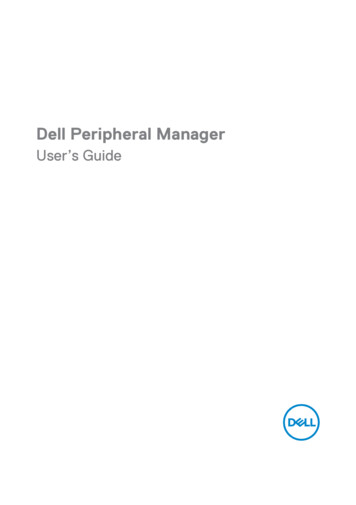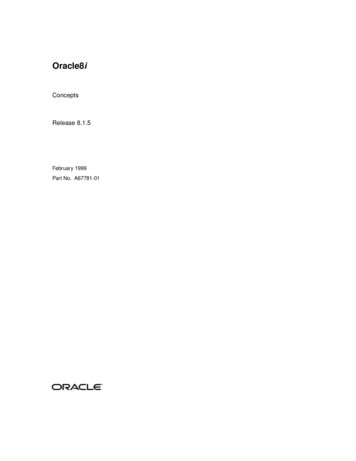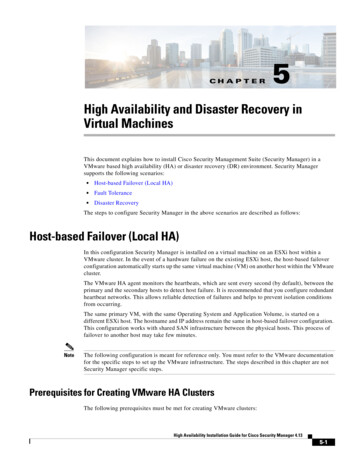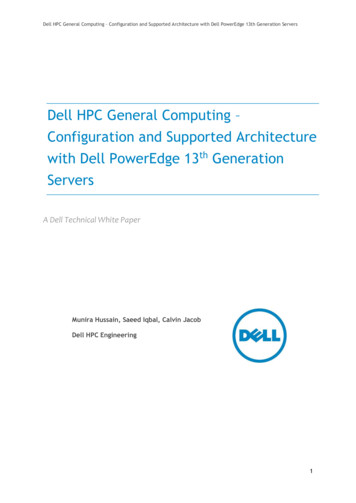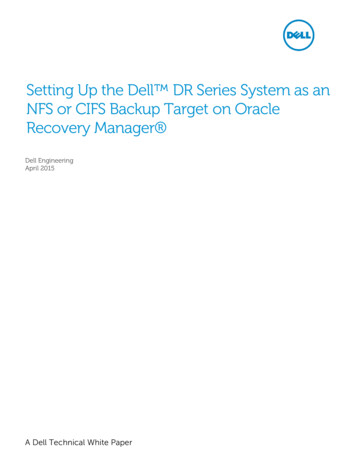
Transcription
Setting Up the Dell DR Series System as anNFS or CIFS Backup Target on OracleRecovery Manager Dell EngineeringApril 2015A Dell Technical White Paper
RevisionsDateDescriptionApril 2015Initial releaseTHIS WHITE PAPER IS FOR INFORMATIONAL PURPOSES ONLY, AND MAY CONTAIN TYPOGRAPHICAL ERRORS ANDTECHNICAL INACCURACIES. THE CONTENT IS PROVIDED AS IS, WITHOUT EXPRESS OR IMPLIED WARRANTIES OFANY KIND. 2015 Dell Inc. All rights reserved. Reproduction of this material in any manner whatsoever without the expresswritten permission of Dell Inc. is strictly forbidden. For more information, contact Dell.PRODUCT WARRANTIES APPLICABLE TO THE DELL PRODUCTS DESCRIBED IN THIS DOCUMENT MAY BE FOUNDAT: ommercial-and-public-sector Performance of networkreference architectures discussed in this document may vary with differing deployment conditions, network loads, andthe like. Third party products may be included in reference architectures for the convenience of the reader. Inclusionof such third party products does not necessarily constitute Dell’s recommendation of those products. Please consultyour Dell representative for additional information.Trademarks used in this text:Dell , the Dell logo, and PowerVault are trademarks of Dell Inc. Other Dell trademarks may be used in thisdocument. Microsoft , Windows , Windows Server , Internet Explorer , MS-DOS , Windows Vista and ActiveDirectory are either trademarks or registered trademarks of Microsoft Corporation in the United States and/or othercountries. Red Hat and Red Hat Enterprise Linux are registered trademarks of Red Hat, Inc. in the United Statesand/or other countries. Novell and SUSE are registered trademarks of Novell Inc. in the United States and othercountries. Oracle is a registered trademark of Oracle Corporation and/or its affiliates. Other trademarks and tradenames may be used in this document to refer to either the entities claiming the marks and/or names or their productsand are the property of their respective owners. Dell disclaims proprietary interest in the marks and names of others.2Setting Up the Dell DR Series System as an NFS or CIFS Backup Target on Oracle Recovery Manager April 2015
Table of contents1Installing and configuring the DR Series system . 52Configuring a backup job on RMAN over a CIFS target . 1232.1Oracle settings for Windows RMAN Online Backup . 122.2Default RMAN backup configuration. 122.3RMAN backup settings to DR Series system backup . 122.4RMAN backup of full database . 132.5RMAN incremental backup of database . 132.6Backup with different options . 142.7RMAN restore of Oracle database from DR Series system . 142.8RMAN restore of archive logs from DR Series system images . 15Replicating Oracle RMAN database images.173.14Configuring a backup job on RMAN over an NFS target . 194.1563RMAN restore from replication DR Series system container .17Create a storage device for NFS . 19Creating a storage device for Rapid CIFS .205.1About the Rapid CIFS plugin .205.2Configure Rapid CIFS.20Creating a storage device for Rapid NFS . 216.1About the Rapid NFS plugin . 216.2Configuring Rapid NFS . 217General best practices for RMAN backups to the DR Series system. 228Setting up the DR Series system cleaner . 249Monitoring deduplication, compression, and performance . 25Setting Up the Dell DR Series System as an NFS or CIFS Backup Target on Oracle Recovery Manager April 2015
Executive summaryThis paper provides guideline about how to set up the Dell DR Series System as a backup to disk target forRMAN over CIFS/Rapid CIFS and NFS/Rapid NFS.For additional information, see the DR Series system documentation and other data managementapplication best practices whitepapers for your specific DR Series system at:http://www.dell.com/powervaultmanualsNote: The DR Series System/RMAN build version and screenshots used for this paper may vary slightly, depending onthe version of the DR Series System/ RMAN software version used.About RMANRMAN (Recovery Manager) is a backup and recovery manager supplied for Oracle databases by the OracleCorporation. Oracle Corporation recommends RMAN as its preferred method for backup and recoveryand has written command-line and graphical (via Oracle Enterprise Manager) interfaces for the product.The following illustration shows a typical implementation of the backup infrastructure with the Dell DRSeries system. The DR Seriees system offers optimized replication of data from one system to another overthe WAN for disaster recovery.Dell DR Series System: RMAN: Baseline Scenarios4Setting Up the Dell DR Series System as an NFS or CIFS Backup Target on Oracle Recovery Manager April 2015
1Installing and configuring the DR Series system1.Rack and cable the DR Series system, and power it on. Initialize the DR Series system.In the Dell DR Series System Administrator Guide, refer to the following topics: “iDRACConnection”, “Logging in and Initializing the DR Series System and “Accessing IDRAC6/Idrac7Using RACADM” for more information.2. Log on to iDRAC using the default address 192.168.0.120, or the IP address that is assigned to theiDRAC interface, with the user name and password: “root/calvin”.3.5Launch the virtual console.Setting Up the Dell DR Series System as an NFS or CIFS Backup Target on Oracle Recovery Manager April 2015
4. After the virtual console is open, log on to the system as user administrator with the passwordSt0r@ge! (The “0” in the password is the numeral zero).5. Set the user-defined networking preferences.6. View the summary of preferences and confirm that it is correct.6Setting Up the Dell DR Series System as an NFS or CIFS Backup Target on Oracle Recovery Manager April 2015
7.Log on to DR Series system administrator console using the IP address you just provided for theDR Series system with the username administrator and password St0r@ge! (The “0” in thepassword is the numeral zero.).8. Join the DR Series system to Active Directory.Note: If you do not want to add the DR Series system to Active Directory, please see the DR SeriesSystem Owner’s Manual for guest logon instructions.a.7Under System Configuration in the left navigation area, click Active Directory.Setting Up the Dell DR Series System as an NFS or CIFS Backup Target on Oracle Recovery Manager April 2015
b. Enter your Active Directory credentials.9. Create and mount the container by selecting Storage Containers in the left navigation area, andthen clicking Create at the top of the page.8Setting Up the Dell DR Series System as an NFS or CIFS Backup Target on Oracle Recovery Manager April 2015
10. Enter a Container Name, click Next.11. Select the NAS (NFS, CIFS) option and click Next.12. Enable the access protocols as needed, and then click Next.9Setting Up the Dell DR Series System as an NFS or CIFS Backup Target on Oracle Recovery Manager April 2015
13. For NFS, provide the client access information and click Next.14. For CIFS, provide the client access control information and click Next.10Setting Up the Dell DR Series System as an NFS or CIFS Backup Target on Oracle Recovery Manager April 2015
Note: For improved security, Dell recommends adding IP addresses for the Backup console (RMAN). Not allenvironments will have all components.15. Click Create a New Container, and then confirm that the container is added.16. Select the Container that was just created and click Edit. Note the container share/export path,which you will use later to target the DR Series system.11Setting Up the Dell DR Series System as an NFS or CIFS Backup Target on Oracle Recovery Manager April 2015
2Configuring a backup job on RMAN over a CIFS target2.1Oracle settings for Windows RMAN Online BackupThere are two options for RMAN to authenticate to the DR Series system through CIFS. DR is joined into an Active Directory Domain: Integrate RMAN Node and DR Series System with ActiveDirectory Ensure the AD user has appropriate ACLs to the DR Series System Container shareDR is standalone CIFS server: Make sure this CIFS user has appropriate access permission to the DRSeries system container share. Oracle RMAN Backup Node will use this user to authenticate to DRSeries system share in Workgroup mode. To set the password for local CIFS administrator on the DR Series system, log on to the DRusing SSH.i. Log on with the username Administrator, and password St0r@ge!ii. Run the following command:authenticate --set --user administratorNote: The CIFS administrator account is a separate account from the administrator account used toadminister the appliance. After an authentication method is chosen, set the RMAN Oracle serviceaccount to use the CIFS administrator account.2.2Default RMAN backup configurationThe Default settings for RMAN are listed below with command show all.2.3RMAN backup settings to DR Series system backupThe RMAN backup settings changed for taking backup to Dell DR Server systems over CIFS.1.12Configure channel to use UNC path of the DR Series system container.Setting Up the Dell DR Series System as an NFS or CIFS Backup Target on Oracle Recovery Manager April 2015
CONFIGURE CHANNEL DEVICE TYPE DISK MAXOPENFILES 1 FORMAT ‘\\ UNCPath tothe container noted above /ora df%t s%s s%p’;2. Configure RMAN to back up the control file after each backup.2.4RMAN backup of full databaseBackup Oracle Database using RMAN with BACKUP INCRMENTAL LEVEL 0 DATABASE FILESPERSET 1;2.5RMAN incremental backup of databaseIncremental Backup Oracle Database using RMAN with BACKUP INCRMENTAL LEVEL 1 DATABASEFILESPERSET 1;13Setting Up the Dell DR Series System as an NFS or CIFS Backup Target on Oracle Recovery Manager April 2015
2.6Backup with different optionsBACKUP ARCHIVELOG ALL;BACKUP DATABASE PLUS ARCHIVELOG;2.7RMAN restore of Oracle database from DR Series systemThe following screen shot shows the restore process of Oracle Database through RMAN from DR Seriessystem images.14Setting Up the Dell DR Series System as an NFS or CIFS Backup Target on Oracle Recovery Manager April 2015
2.8RMAN restore of archive logs from DR Series system imagesRMAN RESTORE ARCHIVELOG ALL;Starting restore at 18-JUN-14using channel ORA DISK 1channel ORA DISK 1: starting archived log restore to default destinationchannel ORA DISK 1: restoring archived logarchived log thread 1 sequence 23channel ORA DISK 1: restoring archived logarchived log thread 1 sequence 24channel ORA DISK 1: restoring archived logarchived log thread 1 sequence 25channel ORA DISK 1: restoring archived logarchived log thread 1 sequence 26channel ORA DISK 1: restoring archived logarchived log thread 1 sequence 27channel ORA DISK 1: restoring archived logarchived log thread 1 sequence 28channel ORA DISK 1: restoring archived logarchived log thread 1 sequence 29channel ORA DISK 1: reading from backup piece\\10.250.242.108\ORARDCIFS\LARGE DF850522883 S6 S1channel ORA DISK 1: piecehandle \\10.250.242.108\ORARDCIFS\LARGE DF850522883 S6 S1 tag TAG20140618T002123channel ORA DISK 1: restored backup piece 1channel ORA DISK 1: restore complete, elapsed time: 00:00:10channel ORA DISK 1: starting archived log restore to default destinationchannel ORA DISK 1: restoring archived logarchived log thread 1 sequence 3015Setting Up the Dell DR Series System as an NFS or CIFS Backup Target on Oracle Recovery Manager April 2015
channel ORA DISK 1: reading from backup piece\\10.250.242.108\ORARDCIFS\LARGE DF850522946 S9 S1channel ORA DISK 1: piecehandle \\10.250.242.108\ORARDCIFS\LARGE DF850522946 S9 S1 tag TAG20140618T002226channel ORA DISK 1: restored backup piece 1channel ORA DISK 1: restore complete, elapsed time: 00:00:01Finished restore at 18-JUN-14RMAN To restore archive logs to a different location, use the following RMAN command. The default location ofthe archive log restore will be where they are created.RUN{SET ARCHIVELOG DESTINATION TO '/oracle/temp restore';RESTORE ARCHIVELOG ALL;}16Setting Up the Dell DR Series System as an NFS or CIFS Backup Target on Oracle Recovery Manager April 2015
3Replicating Oracle RMAN database imagesFirst, you need to create containers on the source and target DR Series systems and then configurereplication between those source and target DR containers. Both of the DR Series systems should be onthe same version. Refer to the Dell DR Series System Administrator’s Guide for information aboutconfiguring cascaded replication.Replication of Oracle Database to target DR Series system3.1RMAN restore from replication DR Series system containerTo restore the Oracle Database from replication container, first detach the replication on the targetcontainer, and run the following commands to import the backup images into the RMAN Catalog.RMAN catalog start with ' UNC Path of the DR replication container ';Searching for all files that match the pattern UNC Path of the DR replicationcontainer List of Files Unknown to the Database File Name UNC Path of the DR replication container \ORA DF848183546 S112 S1File Name: UNC Path of the DR replication container \ORA DF848183663 S114 S1File Name: UNC Path of the DR replication container \ORA DF848183662 S113 S117Setting Up the Dell DR Series System as an NFS or CIFS Backup Target on Oracle Recovery Manager April 2015
Do you really want to catalog the above files (enter YES or NO)? yesCataloging files.Cataloging doneList of Cataloged Files File Name: UNC Path of the DR replication container \ORA DF848183546 S112 S1File Name: UNC Path of the DR replication container \ORA DF848183663 S114 S1File Name: UNC Path of the DR replication container \ORA DF848183662 S113 S118Setting Up the Dell DR Series System as an NFS or CIFS Backup Target on Oracle Recovery Manager April 2015
4Configuring a backup job on RMAN over an NFS target4.1Create a storage device for NFSFor NFS backup using RMAN, a target folder needs to be created as an NFS share directory. This is thelocation to which backup objects will be written. (This is not required while adding CIFS share.)1.Mount the DR Series System NFS share onto the NFS share directory which backup objects will bewritten in the RMAN environment.2. For example:mount –t nfs ip address of DRXXXX :/containers/sample/mnt/RMANtargetContainer3. Verify the NFS share. One way is to try using the Linux command “cat /proc/mounts”. The rsizeand wsize of the connects in the command output should be 512K.In the RMAN settings use the below command to add the NFS mount path as device.CONFIGURE CHANNEL DEVICE TYPE DISK MAXOPENFILES 1 FORMATon RMAN server /ora df%t s%s s%p';'/ Mount point pathNote: Please follow the instructions in Section 3 as the backup and other settings are the same as that ofCIFS.19Setting Up the Dell DR Series System as an NFS or CIFS Backup Target on Oracle Recovery Manager April 2015
5Creating a storage device for Rapid CIFS5.1About the Rapid CIFS pluginRapid CIFS enables write operation acceleration on clients that use CIFS file system protocols. Theseaccelerators allow for better coordination and integration between DR Series systems backup, restore, andoptimized duplication operations with Data Management Applications (DMAs) such as CommVault, EMCNetworker, and Tivoli Storage Manager. For a current list of supported DMAs, see the Dell DR SeriesSystem Interoperability Guide. Rapid CIFS is a Windows-certified filter driver that ensures that only uniquedata is written to the DR Series system. All chunking and hash computations are done at the client level.5.2Configure Rapid CIFSTo configure Rapid CIFS on windows operating systems download and install the pluginDellRapidCIFS-xxxxx.msi on the Oracle server.Refer to the Dell DR Series System Administrator’s Guide for the download location and for moreinformation.Below is the output for Rapid CIFS configured backup.RMAN BACKUP INCREMENTAL LEVEL 1 DATABASE filesperset 1;Starting backup at 02-JUN-14using channel ORA DISK 1channel ORA DISK 1: starting incremental level 1 datafile backup setchannel ORA DISK 1: specifying datafile(s) in backup setinput datafile file number 00001name nnel ORA DISK 1: starting piece 1 at 02-JUN-14channel ORA DISK 1: finished piece 1 at 02-JUN-14piece handle \\SWSYS-33.OCARINA.LOCAL\BACKUP\ORA DF849163738 S17 S1tag TAG20140602T064858 comment NONE----------------Screen O/P truncated----------------------Starting Control File and SPFILE Autobackup at 02-JUN-14piece handle C:\APP\ADMINISTRATOR\PRODUCT\11.2.0\DBHOME 3\DATABASE\C-168923332620140602-03 comment NONEFinished Control File and SPFILE Autobackup at 02-JUN-14To check the Client Side optimization:C:\Program Files\Dell\Rapid CIFS rdcifsctl.exe stats -sAggregate Statistics:Total Bytes Written: 2,411,298,816Total Bytes Sent: 1,378,067,343Total Network Savings: 42.8496C:\Program Files\Dell\Rapid CIFS rdcifsctl.exe stats -sAggregate Statistics:Total Bytes Written: 2,412,691,456Total Bytes Sent: 1,379,461,495Total Network Savings: 42.824820Setting Up the Dell DR Series System as an NFS or CIFS Backup Target on Oracle Recovery Manager April 2015
6Creating a storage device for Rapid NFS6.1About the Rapid NFS pluginRapid NFS enables write operation acceleration on clients that use NFS file system protocols. Theseaccelerators allow for better coordination and integration between DR Series systems backup, restore, andoptimized duplication operations with Data Management Applications (DMAs) such as CommVault, EMCNetworker, and Tivoli Storage Manager. For the current list of supported DMAs, see the Dell DR SeriesSystem Interoperability Guide.Rapid NFS is a client file system type that ensures that only unique data is written to the DR Series system.It uses user space components and file system in user space (FUSE) to accomplish this. Metadataoperations such as file creates and permission changes go through the standard NFS protocol, whereaswrite operations go through Rapid NFS.6.2Configuring Rapid NFSFor Rapid NFS to configure on Linux system we need to install plugin bin file,DellRapidNFS-xxxxx-xxxxx-x86 64.bin.The rpm after install looks like DellRapidNFS-310093.052425.x86 64.1.To mount as Rapid NFS:mount –t rdnfs ip address of DRXXXX :/containers/sample/mnt/RMANtargetContainer2. Verify the NFS share. One way is to try using the Linux command “cat /proc/mounts”. The rsizeand wsize of the connects in the command output should be 512K.Refer to the Dell DR Series System Administrator’s Guide for the download location and for moreinformation.21Setting Up the Dell DR Series System as an NFS or CIFS Backup Target on Oracle Recovery Manager April 2015
7General best practices for RMAN backups to the DR SeriessystemThe Dell DR Series system supports RMAN backups over both CIFS and NFS protocols. With client sideoptimization drivers like Rapid CIFS and Rapid NFS backups become faster and more efficient. Severaloptions exist with RMAN that every DBA should be aware of. These effect how RMAN behaves whenperforming its backup duties. Some of the most important are outlined here because they affect howRMAN will interact with a Dell DR Series deduplication appliance. Refer to Oracle’s documentation formore details.Multiplexing of data is not recommended as it adversely affects the deduplication savings. Every time datagets multiplexed, the patterns may change, and the deduplication algorithm can fail to decipher theduplicates. Specify FILESPERSET 1 when backing up to a DR Series system. FILESPERSET controls howmany data files are written to a particular file within the backup set. Backup database FILESPERSET 1Specify MAXOPENFILES 1 for each channel defined. This will ensure that each RMAN channel onlyreads from a single file at any one time. It is recommended to keep the value at minimum. CONFIGURE CHANNEL DEVICE TYPE DISK MAXOPENFILES 1 FORMAT ' UNCPath of the DRcontainer /ora df%t s%s s%p';Turn on change block tracking by using below command.SQL ALTER DATABASE ENABLE BLOCK CHANGE TRACKING USING FILE ' Path on the RMAN serverOracle Home /oradata/rman change track.f'; Configure RMAN settings to backup control file and SPFILE.Auto backup onCONFIGURE CONTROLFILE AUTOBACKUP ON;Keep CONFIGURE BACKUP OPTIMIZATION OFF every time for better savings.RMAN encryption should NOT be used as the deduplication savings get affected.A listing of the global parameters can be generated by the “show all” RMAN command:RMAN show all;RMAN configuration parameters for database with db unique name APPLE are:CONFIGURE RETENTION POLICY TO REDUNDANCY 1; # defaultCONFIGURE BACKUP OPTIMIZATION OFF; # defaultCONFIGURE DEFAULT DEVICE TYPE TO DISK; # defaultCONFIGURE CONTROLFILE AUTOBACKUP ON;CONFIGURE CONTROLFILE AUTOBACKUP FORMAT FOR DEVICE TYPE DISK TO '%F'; # defaultCONFIGURE DEVICE TYPE DISK PARALLELISM 1 BACKUP TYPE TO BACKUPSET; # defaultCONFIGURE DATAFILE BACKUP COPIES FOR DEVICE TYPE DISK TO 1; # defaultCONFIGURE ARCHIVELOG BACKUP COPIES FOR DEVICE TYPE DISK TO 1; # defaultCONFIGURE CHANNEL DEVICE TYPE DISK FORMAT'/mnt/apple nfs/apple %u %s %p';CONFIGURE MAXSETSIZE TO UNLIMITED; # defaultCONFIGURE ENCRYPTION FOR DATABASE OFF; # defaultCONFIGURE ENCRYPTION ALGORITHM 'AES128'; # default22Setting Up the Dell DR Series System as an NFS or CIFS Backup Target on Oracle Recovery Manager April 2015
CONFIGURE COMPRESSION ALGORITHM 'BASIC' AS OF RELEASE 'DEFAULT' OPTIMIZE FORLOAD TRUE ; # defaultCONFIGURE ARCHIVELOG DELETION POLICY TO NONE; # defaultCONFIGURE SNAPSHOT CONTROLFILE NAME TO'/home/orabase/product/11.2.0/db 1/dbs/snapcf apple.f'; # default23Setting Up the Dell DR Series System as an NFS or CIFS Backup Target on Oracle Recovery Manager April 2015
8Setting up the DR Series system cleanerPerforming scheduled disk space reclamation operations are recommended as a method for recoveringdisk space from system containers in which files were deleted as a result of deduplication.The cleaner runs during idle time. If your workflow does not have a sufficient amount of idle time on adaily basis, then you should consider scheduling the cleaner to force it to run during a scheduled time.If necessary, you can perform the procedure shown in the following screenshot to force the cleaner torun. After all of the backup jobs are set up, the DR Series system cleaner can be scheduled. The DR Seriessystem cleaner should run at least three hours per day when backups are not taking place, and generallyafter a backup job has completed.Dell recommends scheduling the cleaner at a separate time from backup and replication jobs.24Setting Up the Dell DR Series System as an NFS or CIFS Backup Target on Oracle Recovery Manager April 2015
9Monitoring deduplication, compression, and performanceAfter backup jobs have run, the DR Series system tracks capacity, storage savings, and throughput on theDR Series system dashboard. This information is valuable in understanding the benefits of the DR Seriessystem.Note: Deduplication ratios increase over time. It is not uncommon to see a 2-4x reduction (25-50% totalsavings) on the initial backup. As additional full backup jobs are completed, the ratios will increase.Backup jobs with a 12-week retention will average a 15x ratio, in most cases.25Setting Up the Dell DR Series System as an NFS or CIFS Backup Target on Oracle Recovery Manager April 2015
RMAN (Recovery Manager) is a backup and recovery manager supplied for Oracle databases by the Oracle Corporation. Oracle Corporation recommends RMAN as its preferred method for backup and recovery . DR is joined into an Active Directory Domain: Integrate RMAN Node and DR Series System with Active Directory





